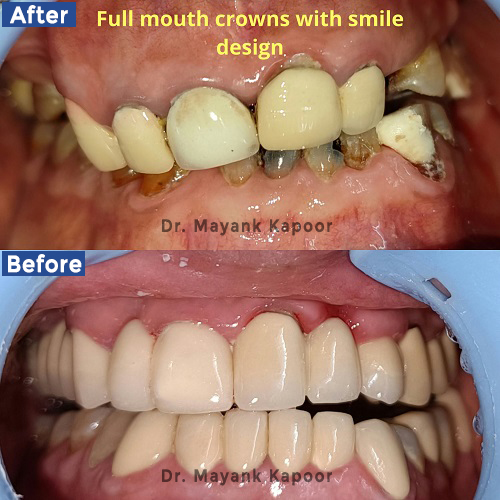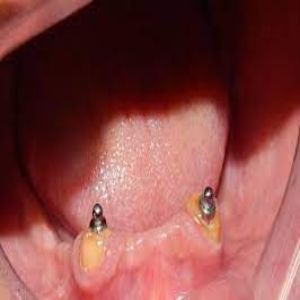Prosthodontia/Prosthetic Rehabilitation
Prosthetic rehabilitation involves restoring oral function and aesthetics through the use of dental prostheses, such as dentures or implants, is a comprehensive treatment approach that involves the restoration and replacement of multiple or all teeth in the mouth. It is typically undertaken to address complex dental problems, such as severe tooth decay, extensive tooth loss, bite misalignment, or significant damage to the teeth and supporting structures.
Fixed Treatments

Veneers ANDLaminates
Dental laminates, also known as dental veneers or porcelain veneers, are thin, custom-made shells that are bonded to the front surface of teeth to improve their appearance.
They are typically made of porcelain or composite resin and are designed to resemble natural teeth in color, shape, and translucency. Dental veneers are a popular cosmetic dentistry option used to address various aesthetic concerns, such as stained or discolored teeth, chipped or worn enamel, uneven spacing or alignment, and teeth with irregular shapes. Veneers can create a bright, symmetrical, and uniform smile, providing a durable and long-lasting solution for enhancing the appearance of teeth.

Crowns and Bridges
Dental crowns and bridges are common restorative dental prostheses used to repair damaged teeth or replace missing teeth.
A dental crown is a tooth-shaped cap that is placed over a damaged or weakened tooth to restore its strength, shape, size, and appearance. Crowns are typically made from materials like porcelain, metal alloys, or a combination of both. They provide protection to the underlying tooth and can improve its function and aesthetics.
A dental bridge, on the other hand, is used to replace one or more missing teeth. It consists of one or more artificial teeth, called Pontics.

Full mouth restoration
Dental full mouth rehabilitation, also known as full mouth reconstruction, is a comprehensive dental treatment that aims to restore the health, function, and aesthetics of the entire mouth. It involves the simultaneous restoration or replacement of multiple or all teeth in both the upper and lower jaws. This complex procedure addresses various dental issues, including severe tooth decay, gum disease, bite misalignment, tooth loss, and jaw joint problems.
The ultimate goal is to improve oral health, restore proper chewing and speaking abilities, and enhance the overall appearance of the smile.
Rehabilitation of Single Tooth/Multiple Teeth
Rehabilitation of single tooth or multiple teeth refers to the process of restoring and rebuilding a damaged or missing tooth (or teeth) to bring back its normal function, aesthetics, and overall oral health. There are several ways to rehabilitate a single tooth or multiple teeth, depending on the extent of damage or loss.
Rehabilitation of Single Tooth/Multiple Teeth with Crowns and Bridges
Rehabilitation of single tooth or multiple teeth using crowns and bridges is a common dental treatment to restore damaged or missing teeth. The process begins with the dentist preparing the affected tooth by removing any decayed or damaged areas and shaping it to accommodate the crown. An impression of the prepared tooth is taken, which serves as a model for creating the permanent crown in a dental laboratory. While the permanent crown is being fabricated, a temporary crown may be placed on the prepared tooth to protect it.
Rehabilitation of Single Tooth/Multiple Teeth with Crowns and Bridges
Rehabilitation of single tooth or multiple teeth using dental implants is a modern and highly effective method for replacing missing teeth. Dental implants are artificial tooth roots made of biocompatible materials, typically titanium, which are surgically placed into the jawbone. Once integrated with the bone through a process called osseointegration, they provide a strong foundation for attaching artificial teeth. Rehabilitation with dental implants can significantly enhance a patient’s quality of life by restoring their ability to eat, speak, and smile with confidence.
Semi-Fixed Treatments

endodontic studd attachments
Endodontic stud attachments are specialized devices used in dental restorations to provide support and retention for dental prostheses. They are typically placed inside the root canal of a tooth that has undergone root canal treatment. These attachments serve as anchors for the attachment of crowns, bridges, or removable partial dentures, ensuring stability and longevity of the dental restoration.

ball AND socketattachments
Ball and socket attachments, also known as ball attachments, are a type of dental implant attachment used in prosthodontics. They consist of a ball-shaped attachment on one component that fits into a socket on another component. This allows for secure retention and stability of removable dental prostheses, such as dentures or partial dentures, providing improved comfort and functionality for the patient.

Ball & Socket Dental implants
Dental implants are artificial tooth roots that are surgically placed into the jawbone to support replacement teeth. They provide a strong foundation for dental crowns, bridges, or dentures. Dental implants are designed to look, feel, and function like natural teeth, offering a durable and long-lasting solution for individuals with missing teeth.


